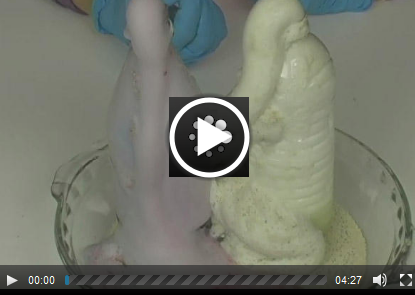Hydrogen peroxide is used to fuel rockets, airplanes, and other vehicle engines. Chemistry teachers everywhere use it to demonstrate the power of a catalyst.
To speed up a reaction without altering the chemistry of the reaction involves adding a catalyst. A catalyst changes the rate of reaction but doesn’t get involved in the overall chemical changes.
For example, leaving a bottle of hydrogen peroxide outside in the sunlight will cause the hydrogen peroxide to decompose. However, this process takes a long time, and if you don’t want to wait, you can simply toss in a lump of charcoal to speed things along.
The carbon is a catalyst in the reaction, and the overall effect is that instead of taking two months to generate a balloon full of oxygen, it now only takes five minutes. The amount of charcoal you have at the end of the reaction is exactly the same as before it started.
A catalyst can also slow down a reaction. A catalytic promoter increases the activity, and a catalytic poison (also known as a negative catalyst, or inhibitor) decreases the activity of a reaction. Catalysts offer a different way for the reactants to become products, and sometimes this means the catalyst reacts during the chemical reaction to form intermediates. Since the catalyst is completely regenerated before the reaction is finished, it’s considered ‘not used’ in the overall reaction.
In this experiment, you’ll see that there’s a lot of oxygen hiding inside the peroxide – enough to really make things interesting and move around! You’ll also find out what happens to soap when you bubble oxygen through it. Are you ready?
Please login or register to read the rest of this content.


I like it!
COOOOOOOOOOOL!!!!!!!!!!!!!!!!!!!!!!!!!!!!!!1
It may me that your solution wasn’t warm enough when you added the yeast. You want to warm your solution in a microwave so it is about 95 to 100 degrees Fahrenheit.
Okay, you didn’t mix it in the video. But the problem is I can’t make the liquid rise faster like you. How can I do that?
Yes you will need to mix it to start the reaction (in the video, I inverted the solution to mix it up). I would take a look at how fresh the yeast is, how much of each you used, and see if you can try different amounts of each to get a bigger reaction (HINT: That’s the way a real scientist would do it – don’t get discouraged, get curious and see if you can figure it out!)
What did you have in mind?
Can you substitute the materials?
I did the dinosaur toothpaste but it didn’t do well. We had to mix it with a spoon to make it go. How do you make it rise to the top of the cup faster?